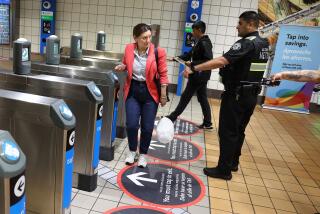Norway Experiment Offers Hope to Congested Cities
- Share via
TRONDHEIM, Norway — It’s 5:59 p.m. on a normal workday. A dozen cars suddenly pull off to the side of the road and stop. A minute later, the whole group resumes the evening commute as if on cue.
Such abrupt stops are a side effect of “road pricing,” a program in this Norwegian city in which drivers have to pay to enter the center of town between 6 a.m. and 6 p.m. The experiment is part of a study for the European Union.
Like many cities around the world, Trondheim, founded 1,001 years ago, is struggling to cope with a steady increase in health-damaging smog and noise from traffic jams on streets often more suited to horse carts than horseless carriages.
Even a small change in traffic can have a large impact on travel time and pollution, according to Norwegian studies.
Seeking to ease the traffic chokehold by discouraging driving, this city of 140,000 people installed the world’s first fully automatic “toll ring” in 1991. Unmanned electronic toll booths deduct a fee from a windshield-mounted gadget on cars that pass during the business day.
Dozens of similar projects are being tested or opened around the world by cities battling the private automobile, with mixed results.
In Trondheim, cars sometimes screech to a halt on the highway just before rush hour ends because it’s free to pass toll stations between 6 p.m. and 6 a.m. as well as on weekends. During the toll hours, it costs up to 12 kroner ($1.60) to drive into the toll zone.
“The aim in ‘congestion pricing’ is to take the peak off traffic during the rush hour,” said Terje Tretvik at the SINTEF research institute in Trondheim, about 300 miles north of Oslo.
He said the tolls reflect the environmental, road-building and social expenses of heavy traffic “so drivers personally feel the cost.”
If sudden stops in the evening and commuters speeding to beat the start of tolls in the morning are the negative effects, the “Trondheim Package” has also shown benefits.
When the system was introduced, peak rush-hour traffic immediately dipped 10% as people adjusted their schedules to avoid the toll. Revenues from the tolls have paid to improve roads and build bypasses to cut traffic congestion. Income is also used to give commuters other options by upgrading public transit, building bicycle paths and even providing 200 free bicycles for use downtown.
“One of the main points in winning acceptance is to make sure the public knows how the money is going to be used,” said Tore Langmyhr, another traffic researcher at SINTEF.
In March, Singapore opened a similar toll system and reported a decline in rush-hour traffic.
The English city of Leicester in June completed a two-year test of road pricing for the EU. A preliminary report said increasing the cost of driving doubled the number of people using the single park-and-ride bus station to 3,150 a week.
Even when traffic is reduced, rush-hour fees aren’t popular with everyone.
“It is idiotic,” grumbled Trond J. Volem, a harried father who was loading a youngster into a faded blue sedan so he could race off to another part of Trondheim to pick up his other child. “Most days I have to go through the ring at least four times. We have small children, and have enough other expenses.”
Still, opposition to the tolls has declined from an overwhelming 70% in polls taken when the system opened to less than 50% now.
Terje Hoven, of the national highway department’s Trondheim office, said a similar system could benefit big cities like Paris on high smog days “because the toll could be doubled or tripled to cut traffic.”
But while many people complain about traffic, few are ready to support such a plan.
“The principal problem has been to get a toll-ring system approved in a democratic system,” Hoven said. “Throughout Europe, they have talked about it but haven’t been able to do it. The process is 10% technical and 90% political.”
Easing traffic by a small margin can cut congestion and smog. Studies say that if traffic exceeds a road’s capacity by 5%, travel time can double, Tretvik said. So cutting 10% off the rush-hour peak eases traffic jams, pollution and the need for new roads.
The brain of the Norwegian system is a locally produced electronic tag called Q-Free. When a car passes a toll station, a radar beam is bounced off the tag mounted in the windshield. That allows a computer to identify the car and deduct the toll from a prepaid account.
During peak rush hours in Trondheim, demand for highway space goes up, and so do toll prices, by as much as 50%.
The automatic stations are almost invisible, which in itself may be a problem.
“Maybe it is too painless,” Hoven said. “People don’t notice when they pay, as long as it is totally electronic. Maybe in the future, there will be displays that show drivers how much it costs them each time.”
More to Read
Sign up for Essential California
The most important California stories and recommendations in your inbox every morning.
You may occasionally receive promotional content from the Los Angeles Times.













